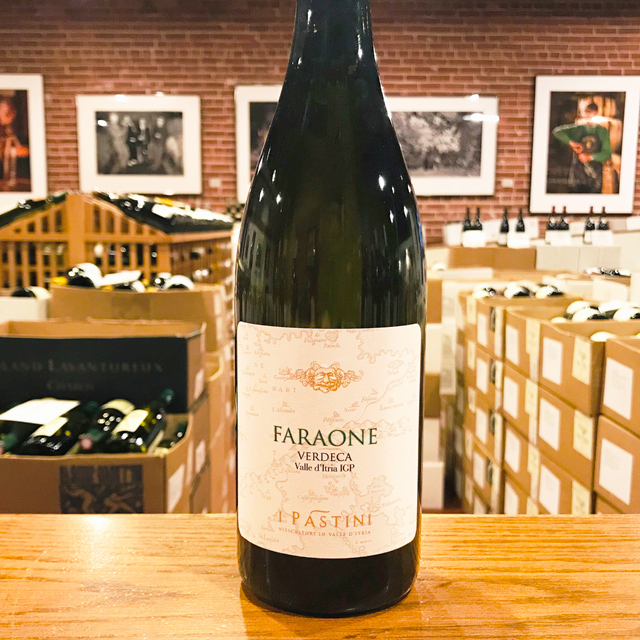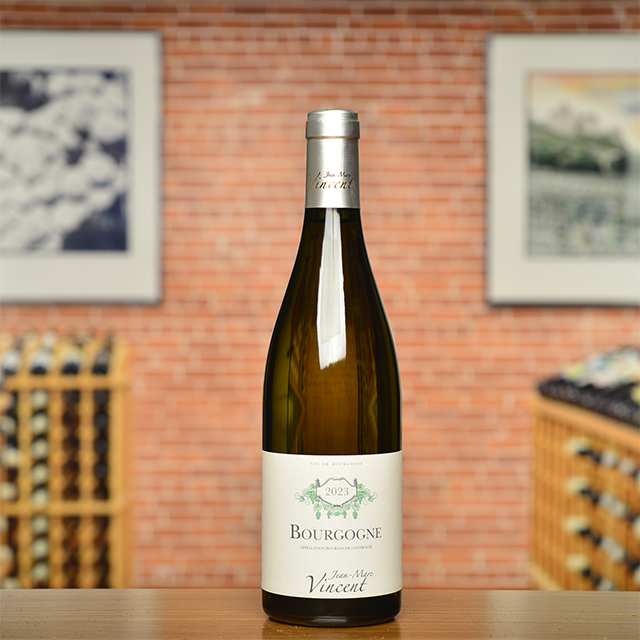Notify me
2019 Valle d’Itria Bianco “Faraone”
I Pástini
Our first-ever foray into the heel of the Italian boot might not be what you expect. It certainly wasn’t what I expected! On a trip there last July, I discovered a terroir perfectly suited to producing dry, aromatic white wines of character and freshness. Puglia is the likely birthplace of Italian wine (and, as follows, French wine!), with the vine originally traveling here via Greek settlers who crossed the Adriatic channel. Today it is the second-largest producer of wine out of Italy’s twenty regions. Most of it is red. I Pástini is a small, family-run winery in the Valle d’Itria in eastern central Puglia. Gianni Carparelli and his father, Donato, founded I Pástini so that they could bottle their own production from land used by their forebears to grow wine grapes for sale. Their organically grown grapes thrive on a limestone plateau co-planted to ancient (multi-millennia-old!) olive groves overlooking the Adriatic Sea. Located roughly in between the coastal towns of Brindisi and Bari, the Valle d’Itria is made up of a dozen or so small, agrarian towns distinguished by their trulli, conically shaped stone structures that historically served to house people, store grain and other foodstuff, and shelter livestock.
The Carparellis produce a beautiful range of white wines, including the Faraone, which is made from the local Verdeca grape (which is genetically similar to Verdicchio in Le Marche). This stimulating dry white is a wonderfully versatile table wine that is crisp, floral, herbaceous, and cleansing. A perfect introduction to I Pástini’s style, it is the type of white you might like to consume often and plentifully.
—Dixon Brooke
| Wine Type: | white |
| Vintage: | 2019 |
| Bottle Size: | 750mL |
| Blend: | Verdeca |
| Appellation: | Valle d’Itria IGP |
| Country: | Italy |
| Region: | Puglia |
| Vineyard: | 3 ha, planted in 2001 |
| Soil: | Red clay, limestone |
| Farming: | Organic (certified) |
| Alcohol: | 12% |
More from this Producer or Region

2024 Valle d’Itria Rosato “Le Rotaie”
Italy | Puglia
A delicious aperitivo, it can seamlessly pair with anything you throw its way.

2024 Locorotondo Bianco “Antico”
Italy | Puglia
Open this alongside a bowl of fennel taralli, the donut-shaped Puglian cracker that has become my go-to aperitivo snack.

2024 Valle d’Itria Bianco “Faraone”
Italy | Puglia
A crisp white wine from a hot climate almost seems like a magical impossibility, yet here’s one, and a delicious one at that.

2024 Valle d’Itria Minutolo “Rampone”
Italy | Puglia
December Club Bianco ~ Crafted from the local variety Minutolo, Pástini’s Rampone preserves lip-smacking acidity and low alcohol despite the baking-hot Puglian summers
About The Region
Puglia

Puglia is Italy’s second most prolific wine-producing region (after the Veneto) and for decades was known as a source of bulk wine. But today, the heel of the boot is more than ever focused on quality, as ambitious growers seek to take advantage of the area's abundant natural riches to produce wines of character and identity. The hot, dry climate and marine influence from the long Adriatic coastline predispose Puglia to growing high-quality fruit, while a wealth of fascinating indigenous grape varieties thrive in these conditions. Changing fashion and a growing respect for the region's mostly calcareous terroirs have breathed fresh air into the Puglian wine scene, and with more than thirty distinct appellations, it is home to a tremendous variety of styles.
While the region is best known for inky, concentrated reds from grapes such as Primitivo and Negroamaro, the first KLWM Puglian imports are in fact white wines—aromatic charmers made from native varieties including Verdeca and the rare Minutolo. They hail from central Puglia’s Valle d’Itria, a plateau that shares a relatively flat topography and limestone soils with the Salento peninsula in the south. The north, in contrast, is hillier and features grapes more common to southern and central Italy including Montepulciano, Sangiovese, and Trebbiano.
Puglian wines are the product of intense southern sunshine and an ancient history of viticulture. With other local specialties including olive oil and burrata, the region has enormous potential for delicious combinations.
More from Puglia or Italy
2023 Colline Savonesi Mataòssu “Vigneto Reiné”
Punta Crena Italy | Liguria
2024 Valle d’Itria Minutolo “Rampone”
I Pástini Italy | Puglia
2023 Colli Trevigiani Manzoni Bianco
Gregoletto Italy | Veneto
2024 Valle d’Itria Rosato “Le Rotaie”
I Pástini Italy | Puglia
2020 Barolo “Le Coste di Monforte”
Piero Benevelli Italy | Piedmont
2024 Vino Rosso “Il Goccetto”
Tenuta La Pergola Italy | Piedmont
2024 Locorotondo Bianco “Antico”
I Pástini Italy | Puglia
2021 Isola Dei Nuraghi Bianco “Prama Dorada”
Deperu Holler Italy | Sardinia
2018 Refosco dal Peduncolo Rosso “Morus Nigra”
Vignai da Duline Italy | Friuli
2022 Südtirol Eisacktaler Riesling
Manni Nössing Italy | Alto Adige
Prosecco Superiore Brut
Sommariva Italy | Veneto
2024 Valle d’Itria Bianco “Faraone”
I Pástini Italy | Puglia
2023 Colline Savonesi Mataòssu “Vigneto Reiné”
Punta Crena Italy | Liguria
2024 Valle d’Itria Minutolo “Rampone”
I Pástini Italy | Puglia
2023 Colli Trevigiani Manzoni Bianco
Gregoletto Italy | Veneto
2024 Valle d’Itria Rosato “Le Rotaie”
I Pástini Italy | Puglia
2020 Barolo “Le Coste di Monforte”
Piero Benevelli Italy | Piedmont
2024 Vino Rosso “Il Goccetto”
Tenuta La Pergola Italy | Piedmont
2024 Locorotondo Bianco “Antico”
I Pástini Italy | Puglia
2021 Isola Dei Nuraghi Bianco “Prama Dorada”
Deperu Holler Italy | Sardinia
2018 Refosco dal Peduncolo Rosso “Morus Nigra”
Vignai da Duline Italy | Friuli
2022 Südtirol Eisacktaler Riesling
Manni Nössing Italy | Alto Adige
Prosecco Superiore Brut
Sommariva Italy | Veneto
2024 Valle d’Itria Bianco “Faraone”
I Pástini Italy | Puglia
Kermit once said...

Kermit once said...
Let the brett nerds retire into protective bubbles, and whenever they thirst for wine it can be passed in to them through a sterile filter. Those of us on the outside can continue to enjoy complex, natural, living wines.
Inspiring Thirst, page 236














